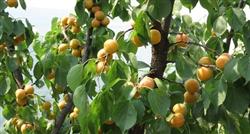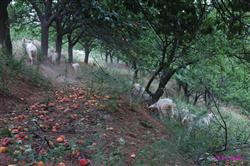apricot acid Learn more about apricot acid
-
Processing of apricot juice

Process material selection → cleaning → crushing → pre-cooking → pressing → rough filtration → clarification → fine filtration → homogenization → deoxidization → adjustment sugar acidity → canned → sterilization → product. Processing key points: apricot fruit with good flavor, slightly higher acidity, easy juice extraction, more juice, orange-yellow pulp, fully ripe, insect-free and injury-free. Before processing, wash the apricot fruit with clean water, cut it in half and enucleate. It is best to cut the apricot meat into 3mm-4mm pieces for crushing and pre-cooking.
2019-01-16 -
Processing Technology of dried Apricot Juice

Apricot is one of the ancient cultivated tree species in China, which is widely distributed. Apricot fruit is rich in vitamins and minerals. It contains 10g sugar, 0.9g protein, 1.79g carotene, 0.02 mg thiamine, riboflavin 0.03mg, nicotinic acid 0.6mg and vitamin C7 mg per 100g pulp. Almonds contain about 23% protein, 50% fat and 60% fat, with an oil yield of 45.8%, and are rich in nutrients such as phosphorus, calcium, potassium and iron needed by the human body.
2019-01-11 -
Development and Utilization of Kernel Apricot Pulp

1, dried apricot processing 1, technological process: apricot meat → cleaning → fumigated → drying → finished product 2, technical points: ⑴ cleaning. Choose the flesh that is neat, fully ripe, hairless, small and thick, rinse with clean water and drain. ⑵ smoked sulphur. Feed the material basket or bamboo curtain containing apricot slices into the wood frame of the smokehouse, pour the burning charcoal into the iron plate in the center of the smokehouse, quickly sprinkle sulfur (1000 kg apricot slices with 3-4 kg sulfur) on the charcoal, and then leave.
2019-01-16 -
Pulp apricot juice

1. Select fresh fruits with yellow pulp, rich sugar and acid, fully ripe and moderate size, and eliminate miscellaneous residual fruits. 2. Wash and crush the selected apricot fruit, soak it and rinse it with clean water, then use a beater to remove the apricot peel and core and beat the pulp into pulp. 3. Heat the coarse filter and use the press to remove the crude fiber from the apricot pulp. 4. The sugar acidity of coarse filtered apricot juice was detected and adjusted, and the suitable ratio of acid to sugar was 1: 1: 18: 20. 5. Vacuum for degassing homogenization
2019-01-16 -
Processing Technology of Sulfur-free and Low-sugar Preserved Apricot

Yanggaojing apricot is one of the four famous apricots in Shanxi Province. Its single fruit weight is 34.8 g, containing vitamin C 10.4 mg/100g, refractive sugar 13.1%, reducing sugar 4.7%, acid 2.4%. This variety is the best variety for processing preserved apricot. Its aroma is strong, the rate of seed production is low, and the acid content is high. Yanggao preserved apricot is golden and transparent in color, soft in meat, sour and sweet in taste. It is the best preserved fruit. The product has been exported to Southeast Asia and Japan and is praised as "China" in Japanese supermarkets.
2019-01-16 -
It will only be available in June to eat its anti-cancer, anti-cancer, heart disease prevention is a good tonic, but you can't eat too much.

Summer is coming, more and more kinds of fruits are competing on the shelves, and it is no longer dominated by apples, oranges and bananas. A few days ago, I ran into a stall on the side of Xingnong Road. I was afraid of acid, so I bought a jin of yellow apricot to share with my mother. She said that such apricot gravy.
2018-05-30 -
Is the price of high-yield Xinjiang apricot expensive? When does it usually mature?

Xinjiang apricot has a history of more than 2000 years, with a planting area of about 2.5 million mu and an annual output of about 1.5 million tons, ranking first in the country in area and output. Xinjiang apricot is rich in variety, different in size, good in taste and processed into preserved fruit and dried fruit.
2020-11-09 High output Xinjiang apricot price expensive Mo general -
Apricot Varieties and Their Cultural Characteristics

There are 10 species of apricot in the world, 9 of which are common apricot, Siberian apricot, Liao apricot, Tibetan apricot, purple apricot, Zhidan apricot, plum apricot, Zhenghe apricot and plum apricot in China. Among them, common apricot, Siberian apricot, Liao apricot and Mei apricot have many varieties and types. Common apricot is the most widely cultivated species in the world. Variety classification Fresh varieties Excellent fresh varieties of fruit should have a large fruit, attractive appearance, gorgeous, fleshy juicy flesh, fine fiber, sweet and sour taste, rich fragrance and other characteristics
2019-01-16 -
Why do apricot trees have black spots?

Apricot is a kind of deciduous tree. the fruit on apricot is not only delicious, but also its branches, seeds and leaves have different functions. Although it is an important economic fruit tree, it will encounter different problems in the process of planting. Why do apricot trees have black spots?
2020-11-08 Apricot fruit there are black spots is why apricot a kind of -
Processing of apricot pulp beverage

1. Apricot pulp beverage: (1) technological process: raw materials are selected: → washing fruit, → scalding, → breaking, → beating, → filtering, → blending, → degassing, homogenized → sterilization, → canned → sealing. (2) Technical essentials: ① raw material selection: select ripe fruits. If the fruit has low maturity, you can leave it for a few days after ripening and then use it. Remove diseases, insect pests, immature fruits and rotten fruits. ② cleaning: wash the fruit directly with clean water. If there is much dirt in the peel, wash it with detergent and then rinse with clean water.
2019-01-16 -
Development of Golden Sun Apricot Jam

Golden Sun Apricot is an European apricot variety introduced by Shandong Fruit Research Institute in 1993. The fruit has a smooth surface, golden background, red color on the sunny side, very attractive fruit color, yellow pulp, delicate and succulent flesh, less fiber, 14.7% soluble solids, 13.1% total sugar, 1.1% titratable acid, an average fruit mass of 70g, a seedless fruit, and an edible rate of 96.8%. The fruit matured at the end of May and has the ability of white flower fruiting. Early fruit, high yield, stable yield, and resistance to diseases and insect pests, strong adaptability. In view of Mrs. Kim
2019-01-16 -
Processing of canned apricot in syrup

(1) the raw material of the technological process is → raw material treatment, → color protection → lye peeling, → trimming, → pre-cooking → selection, → canning, → filling, juice filling, → heating, exhaust, → cap sterilization, → cooling, → wiping can → finished product. (2) technological points 1. Choose fresh and full apricot fruits with yellow pulp, dense, enucleated or semi-enucleated apricot fruits. Get rid of diseases and insect pests and damaged fruits. Apricot fruit should have a horizontal diameter of more than 30 mm and weigh more than 20 grams. 2. After the qualified apricot fruit is cleaned by raw material treatment, use 0.5-1.5% hydrochloric acid or 0.
2019-01-15 -
What season is the fruit of deciduous trees and apricots? How much is the market price per jin? What's the difference between plum and plum? Can pregnant women eat it?

Apricot is a common fruit in summer in China, its pulp and kernel are edible, and it is a good material for all kinds of salads and snacks, so many people like to eat, what season is apricot fruit? How much is the market price per jin? What's the difference between plum and plum?
2020-11-09 Fallen leaves trees apricots what is season fruit market price -
How to fertilize apricot trees can produce high yield?

How to fertilize apricot trees can produce high yield? Please describe in detail when to apply what fertilizer apricot trees need to grasp the fertilization of each period in order to obtain high yield. for details, you can refer to the following methods: first, pre-flowering fertilizer. Pre-bud fertilization should be applied 15 days before flowering, applying 500 grams of nitrogen, 300 grams of potassium and 200 grams of phosphorus per apricot plant.
2018-07-19 -
Why do apricot trees fall flowers and fruits?

Why do apricot trees fall flowers and fruits? What caused the apricot trees to drop flowers and fruits? Please give a detailed description of the common phenomenon of "full flowers without fruit" or "full flowers and half fruits" in apricot trees. Under normal circumstances, the natural fruit setting rate of apricot trees can only account for about 20% of the total flowers. Apricot trees have obviously fallen three times.
2018-07-19 -
Introduction of two varieties of Kunlun apricot

* * Yecheng second pasture of the third Agricultural Division of the Construction Corps is located in 60km to the south of Yecheng County at the northern foot of Kunqu Mountain, longitude 76 °30 "~ 77 °35" east, latitude 36 °40 "~ 37 °30" north, with an average altitude of 2200-4850m, which belongs to the continental climate of warm temperate zone. The annual average temperature is 5: 8 ℃, the maximum temperature is 36 ℃, the minimum temperature is-25 ℃, the effective accumulated temperature is 2800-3200 ℃, the annual precipitation is 80~200mm, the annual evaporation is 1000~1800mm, and the annual sunshine is 299.
2019-01-16 -
Processing method of preserved apricot fruit

(l) main raw materials (100 jin of finished products) 350-360 jin of apricot and 60-65 jin of sugar. (2) for material selection and pre-processing, the fruit used in the production of preserved apricot should be golden in color, easy to leave kernel, delicate meat, full of toughness, storability, soft after maturity, and intact without diseases and insect pests. Generally speaking, "Tiebada" and "Shanhuang apricot" are more ideal in production. After picking, the fruit is knocked open along the closing line, enucleated and washed. However, the green apricot producing green plum was soaked in 15% salt water for 3 days.
2019-01-16 -
Fine varieties of processed apricot

There are many apricot varieties suitable for processing, such as red jade mainly produced in Licheng, Changqing and Tai'an in Shandong, red red apricot planted in Laoshan and Xiashan in Shandong, red golden hazelnut selected in Zhaoyuan in Shandong, agate apricot introduced from abroad by Shandong Fruit Tree Research Institute, red apricot in string branches planted by landlords such as giant deer and Guangzong in Hebei, Qingxu in Shanxi, Renyi and Pingchuan in Shanxi, Yangshao yellow apricot in Mianchi, Henan Province. Tangwangchuan Dajie apricot grown in Dongxiang, Gansu, Jinmama apricot in Lanzhou, Gansu, Jinxi Dahong apricot in Jinxi, Liaoning and Zhang Gong in Jingyang, Shaanxi.
2019-01-16 -
Nutritional value of Pleurotus eryngii _ efficacy and function of Pleurotus eryngii

Nutritional value of Pleurotus eryngii _ efficacy and function of Pleurotus eryngii
2018-07-07 -
Apricot

1, raw material selection: choose green apricot with a diameter of more than 2 cm, whitening apricot body and hardened apricot kernel (that is, maturity 5ml / 60%). Varieties with thick flesh and small nucleus should be used to remove wind fall, residual times, red hair, scars, over-born, over-ripe or rotten apricots. 2. Blanking: rinse the selected fresh apricot with clean water, then add 12-16% salt, while the rinsed green apricot is not dry, pickle the green apricot by layer-by-layer salt, pickle the green apricot for 10 days, remove the green apricot and expose it to the sun, then dry it into the apricot blank.
2019-01-11
